- Back to Home »
- For Filipinos, despair and prayers
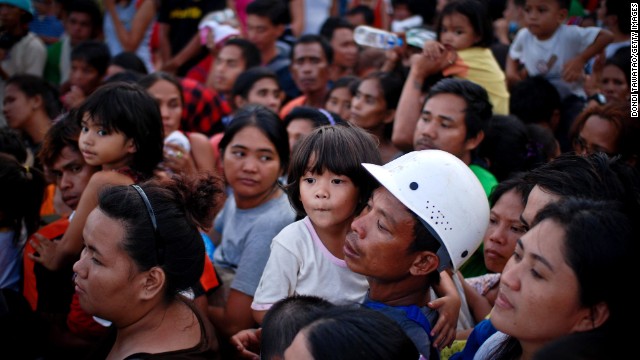 Evacuees wait to board a military aircraft in Leyte, Philippines, on Tuesday, November 12. Typhoon Haiyan, one of the strongest storms in recorded history, laid waste to the Philippines. President Benigno Aquino III said as many as 2,500 people may have been killed by the storm.
Evacuees wait to board a military aircraft in Leyte, Philippines, on Tuesday, November 12. Typhoon Haiyan, one of the strongest storms in recorded history, laid waste to the Philippines. President Benigno Aquino III said as many as 2,500 people may have been killed by the storm. 
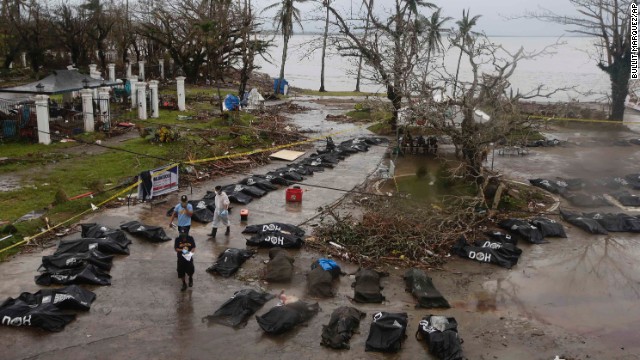 Police line up bodies for processing in Tacloban, Philippines, on November 12.
Police line up bodies for processing in Tacloban, Philippines, on November 12.  People walk through damage in Tacloban on November 12.
People walk through damage in Tacloban on November 12. 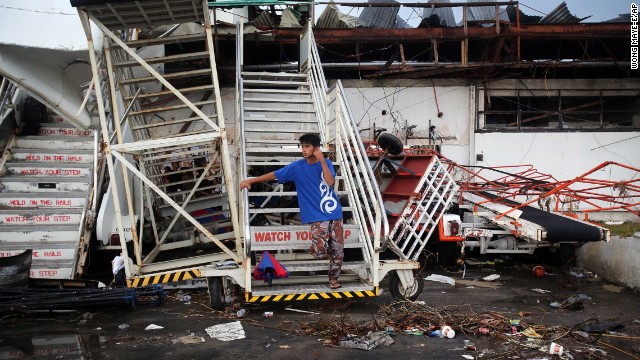 A young man waits at the airport November 12 in hopes of being evacuated from Tacloban.
A young man waits at the airport November 12 in hopes of being evacuated from Tacloban. 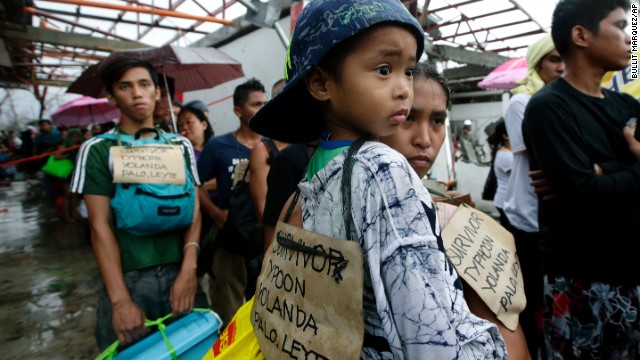 Survivors wait to board a military plane November 12 in Tacloban.
Survivors wait to board a military plane November 12 in Tacloban. 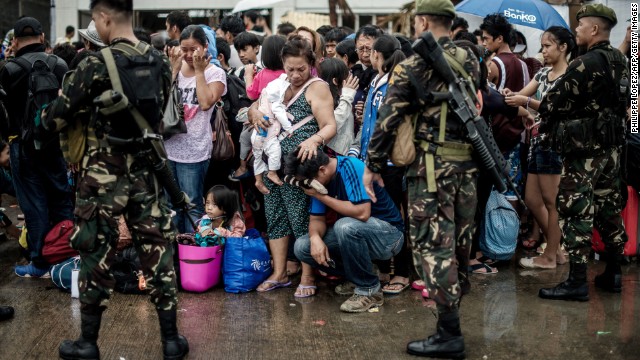 A woman comforts a crying relative as a plane leaves the Tacloban airport November 12.
A woman comforts a crying relative as a plane leaves the Tacloban airport November 12. 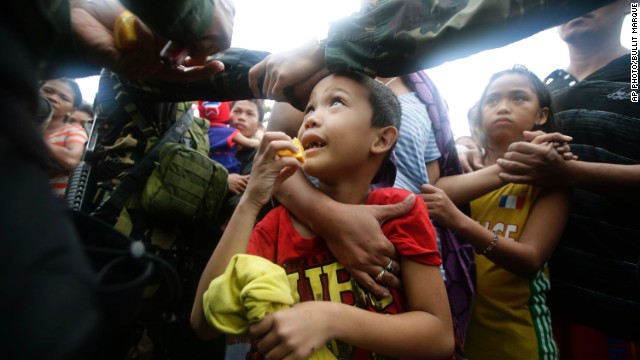 A Philippines air force officer hands out orange slices to typhoon survivors as they line up to board a military plane November 12 in Tacloban.
A Philippines air force officer hands out orange slices to typhoon survivors as they line up to board a military plane November 12 in Tacloban. 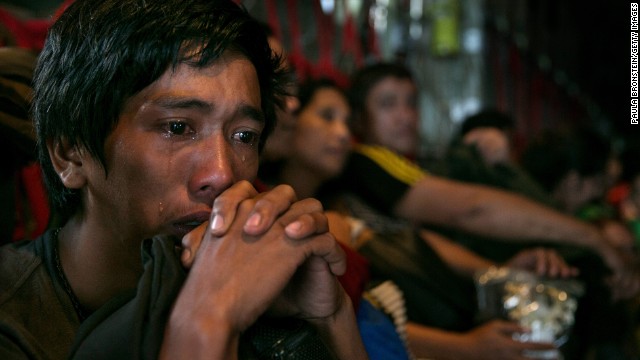 A man sits crying on a packed aircraft in Tacloban on November 12.
A man sits crying on a packed aircraft in Tacloban on November 12. 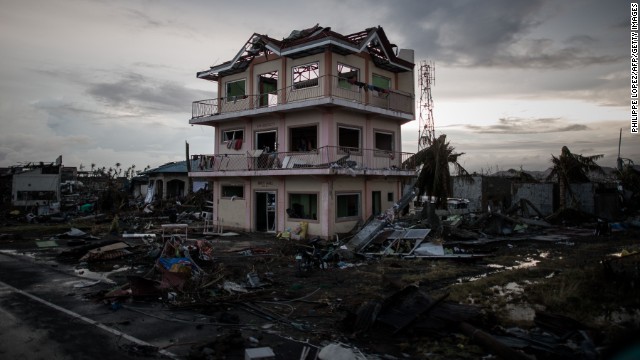 Debris lays scattered around a damaged home near the Tacloban airport on November 12.
Debris lays scattered around a damaged home near the Tacloban airport on November 12. 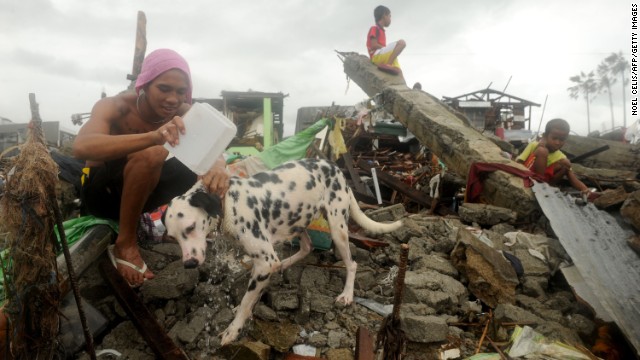 A young man washes his dog November 12 in Tacloban.
A young man washes his dog November 12 in Tacloban. 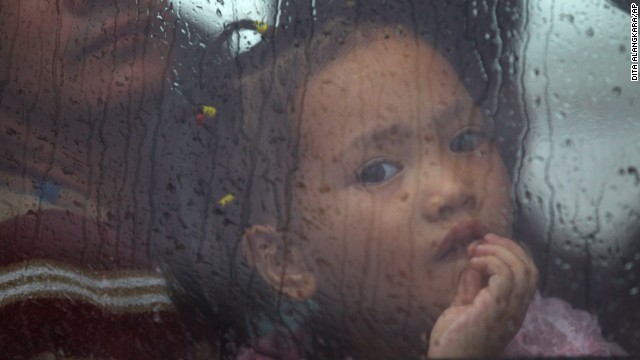 A girl sits inside a bus as she waits for a ferry in Matnog, Philippines, on November 12.
A girl sits inside a bus as she waits for a ferry in Matnog, Philippines, on November 12. 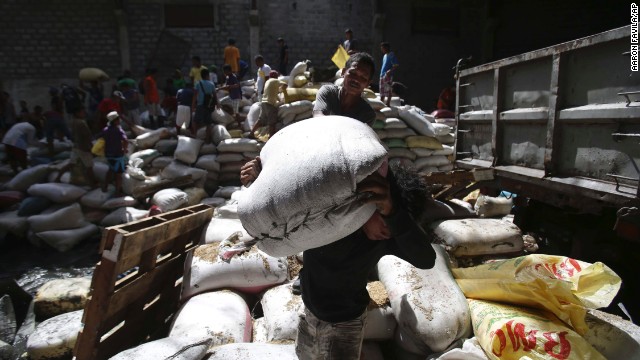 Residents carry bags of rice from a Tacloban warehouse that they stormed November 11 because of a food shortage.
Residents carry bags of rice from a Tacloban warehouse that they stormed November 11 because of a food shortage.  Survivors in Tacloban board a military plane bound for the Philippine capital of Manila on November 11.
Survivors in Tacloban board a military plane bound for the Philippine capital of Manila on November 11. 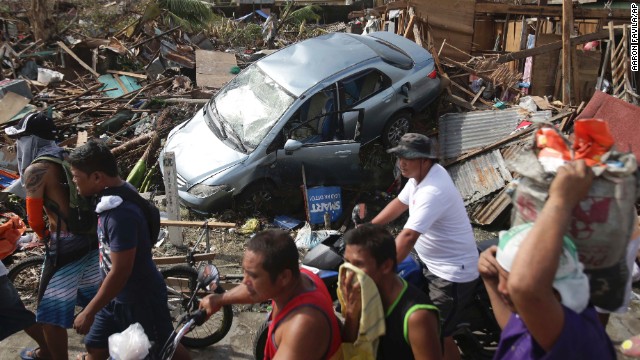 People in Tacloban pass debris on November 11.
People in Tacloban pass debris on November 11. 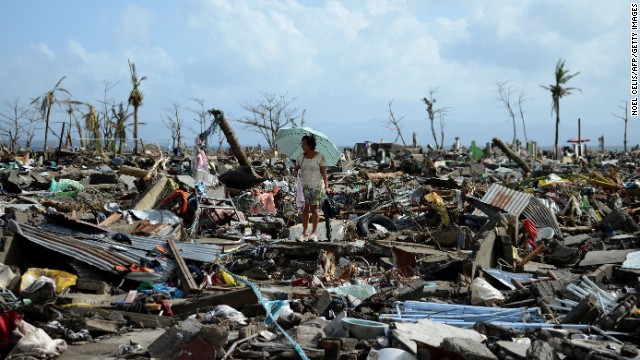 A woman in Tacloban walks amid the debris of destroyed houses on November 11.
A woman in Tacloban walks amid the debris of destroyed houses on November 11. 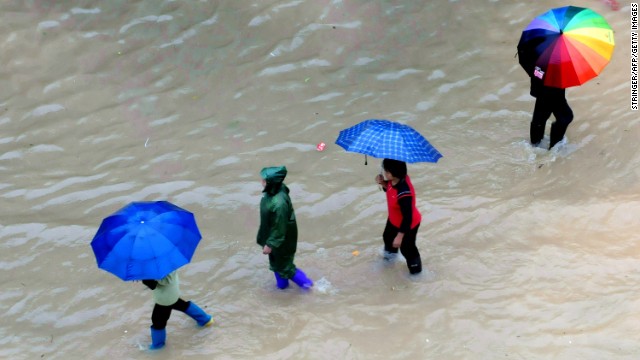 People make their way across a flooded street in Shangsi, China, on November 11. Haiyan moved toward Vietnam and south China after devastating the Philippines.
People make their way across a flooded street in Shangsi, China, on November 11. Haiyan moved toward Vietnam and south China after devastating the Philippines. 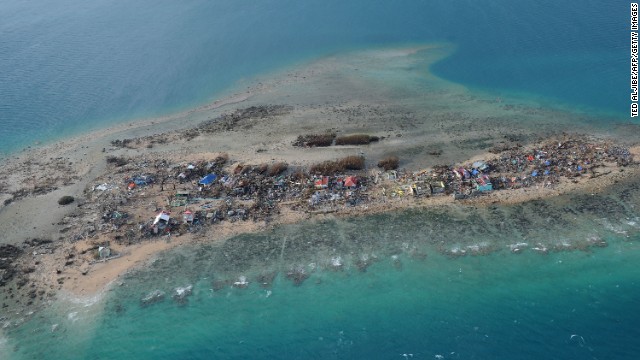 Buildings lie in ruins on Eastern Samar's Victory Island.
Buildings lie in ruins on Eastern Samar's Victory Island. 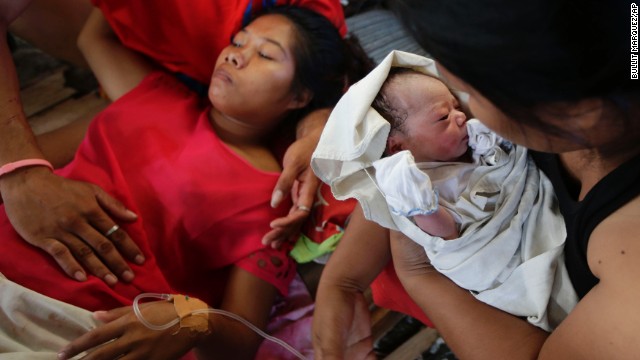 Emily Ortega rests on November 11 after giving birth to Bea Joy at an improvised clinic at the Tacloban airport.
Emily Ortega rests on November 11 after giving birth to Bea Joy at an improvised clinic at the Tacloban airport. 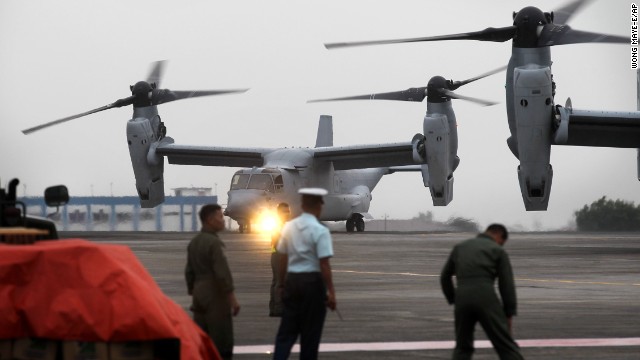 U.S. Marine Corps Osprey aircraft arrive at Manila's Villamor Airbase to deliver humanitarian aid on November 11.
U.S. Marine Corps Osprey aircraft arrive at Manila's Villamor Airbase to deliver humanitarian aid on November 11. 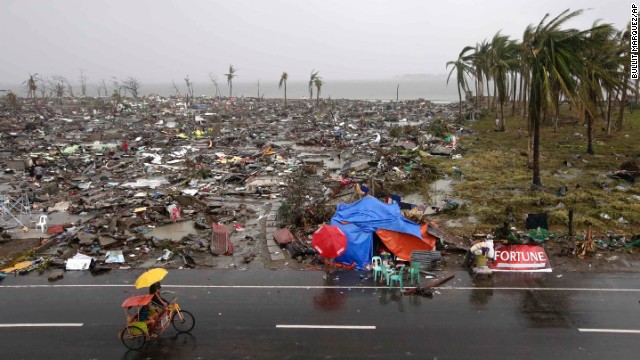 People ride past destruction in Tacloban on Sunday, November 10.
People ride past destruction in Tacloban on Sunday, November 10. 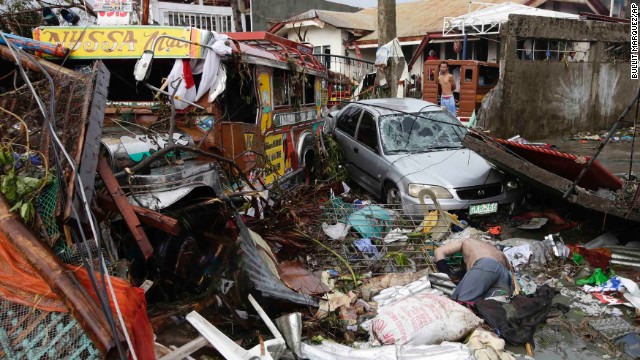 A body lies amid the Tacloban devastation on November 10.
A body lies amid the Tacloban devastation on November 10. 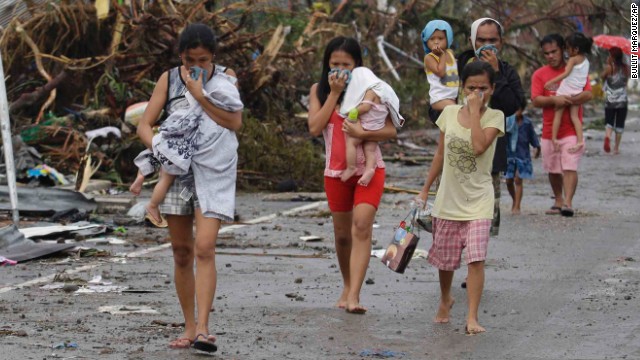 People cover their noses to block the smell of bodies in Tacloban on November 10.
People cover their noses to block the smell of bodies in Tacloban on November 10. 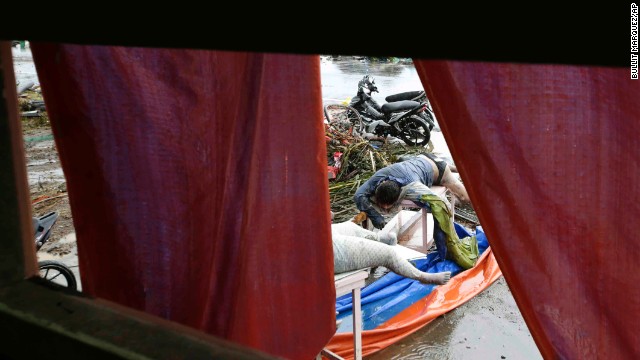 Bodies of victims lie along a Tacloban road on November 10.
Bodies of victims lie along a Tacloban road on November 10. 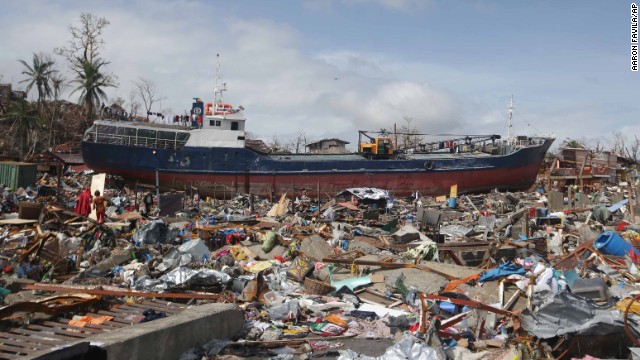 A large boat sits aground, surrounded by debris in Tacloban on November 10.
A large boat sits aground, surrounded by debris in Tacloban on November 10. 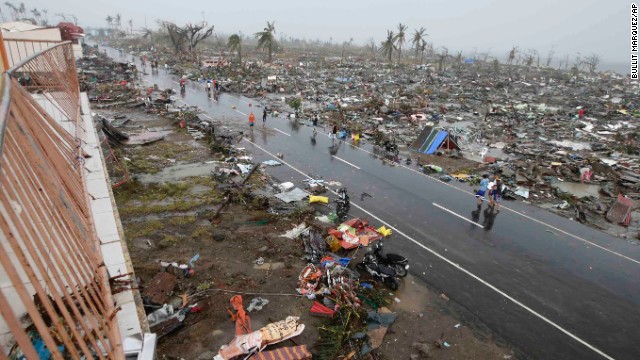 People walk past the Tacloban devastation on November 10.
People walk past the Tacloban devastation on November 10. 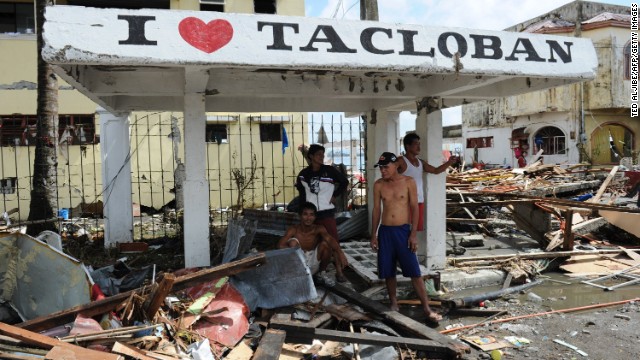 People stand under a shelter in Tacloban.
People stand under a shelter in Tacloban. 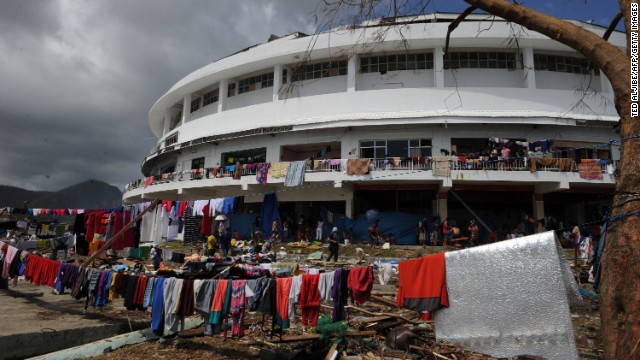 Clothes dry on a line November 10 outside a Tacloban stadium used as an evacuation center.
Clothes dry on a line November 10 outside a Tacloban stadium used as an evacuation center. 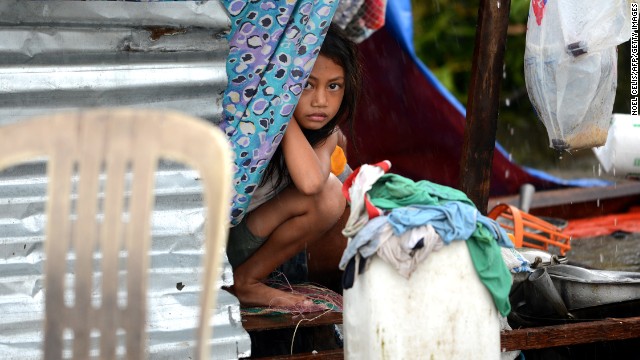 A girl peeks out from a makeshift shelter in Tacloban.
A girl peeks out from a makeshift shelter in Tacloban. 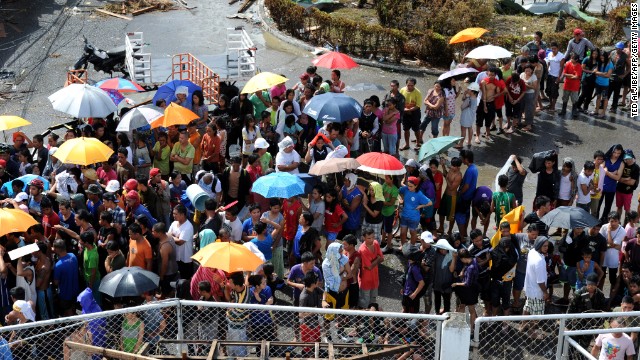 Typhoon survivors wait to receive relief goods at the Tacloban airport on November 10.
Typhoon survivors wait to receive relief goods at the Tacloban airport on November 10. 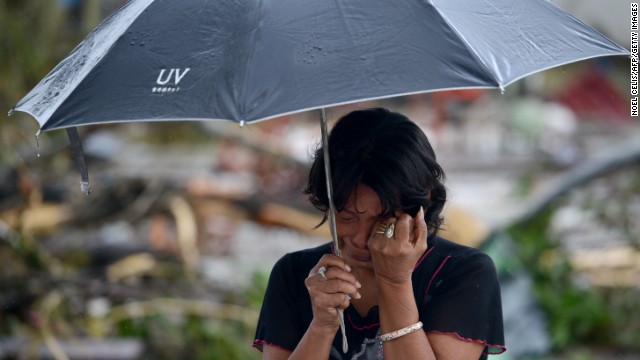 A woman mourns in front of her husband's dead body November 10 in Tacloban.
A woman mourns in front of her husband's dead body November 10 in Tacloban. 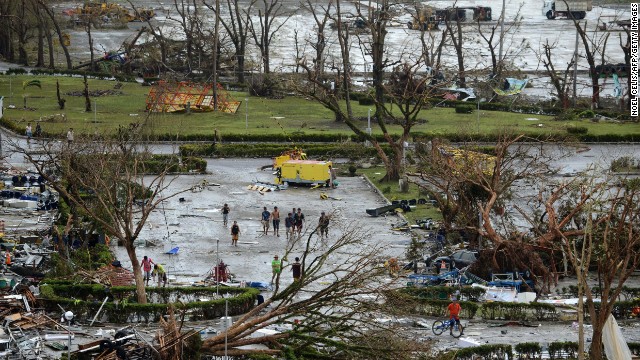 Fallen trees litter the ground at the Tacloban airport on Saturday, November 9.
Fallen trees litter the ground at the Tacloban airport on Saturday, November 9. 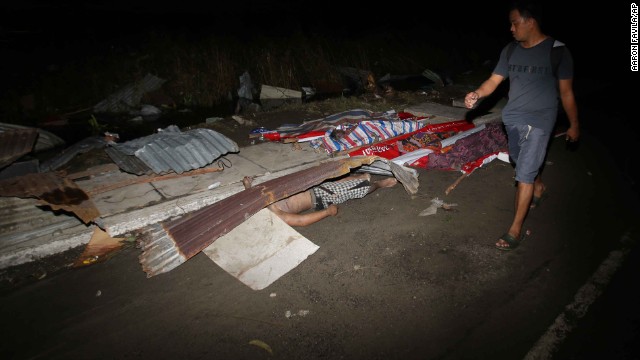 A resident passes victims' bodies on a Tacloban street November 9.
A resident passes victims' bodies on a Tacloban street November 9. 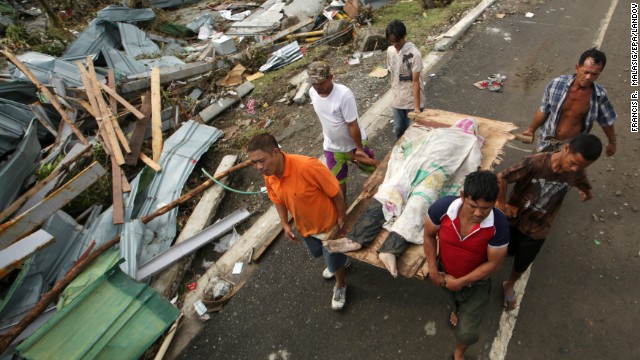 People in Tacloban carry a victim of the typhoon November 9.
People in Tacloban carry a victim of the typhoon November 9. 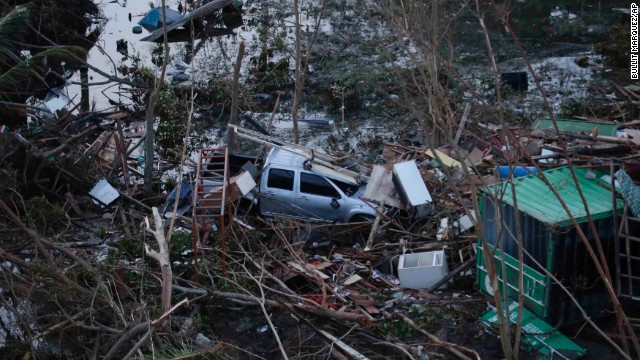 A vehicle lies amid Tacloban debris on November 9.
A vehicle lies amid Tacloban debris on November 9. 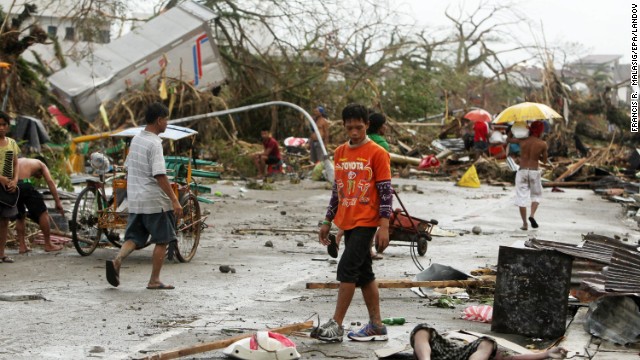 People walk past a victim left on the side of a road in Tacloban.
People walk past a victim left on the side of a road in Tacloban. 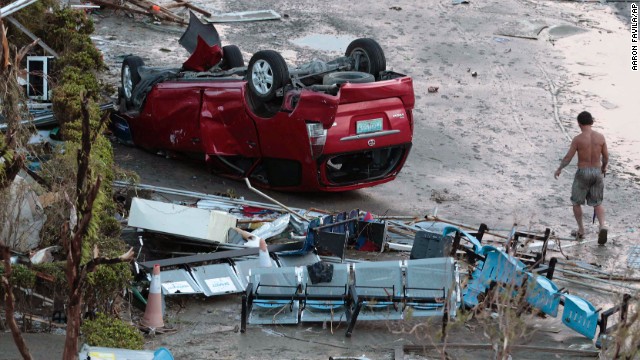 A resident passes an overturned car in Tacloban on November 9.
A resident passes an overturned car in Tacloban on November 9. 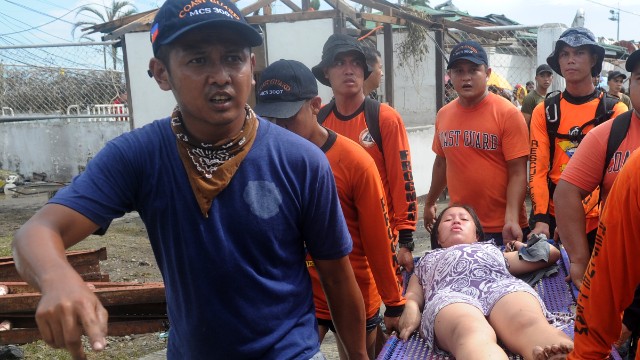 Rescue workers carry a woman about to give birth November 9 at a makeshift medical center at the Tacloban airport.
Rescue workers carry a woman about to give birth November 9 at a makeshift medical center at the Tacloban airport. 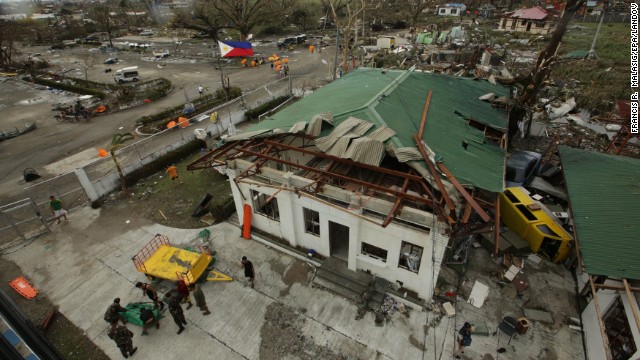 An airport lies in ruins in Tacloban.
An airport lies in ruins in Tacloban. 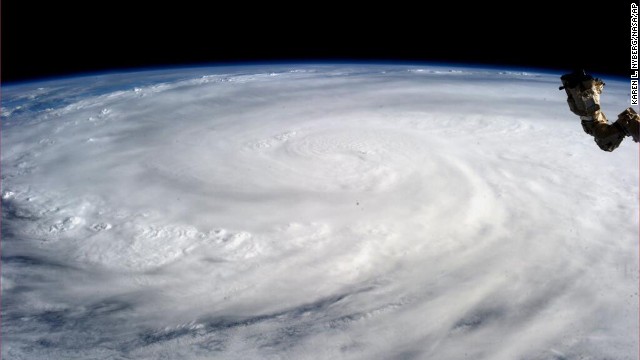 Astronaut Karen L. Nyberg took a picture of the typhoon from the International Space Station on November 9.
Astronaut Karen L. Nyberg took a picture of the typhoon from the International Space Station on November 9. 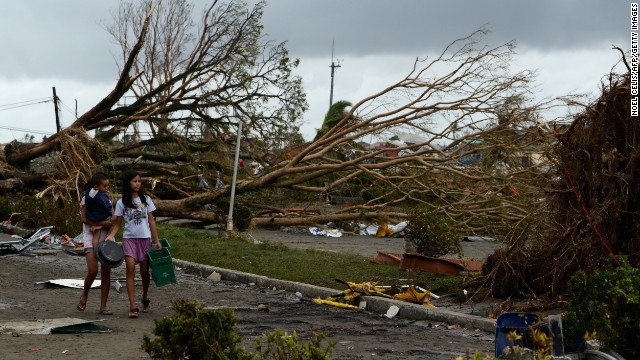 Women walk past fallen trees and destroyed houses in Tacloban on November 9. Residents scoured supermarkets for water and food as they slowly emerged on streets littered with debris.
Women walk past fallen trees and destroyed houses in Tacloban on November 9. Residents scoured supermarkets for water and food as they slowly emerged on streets littered with debris. 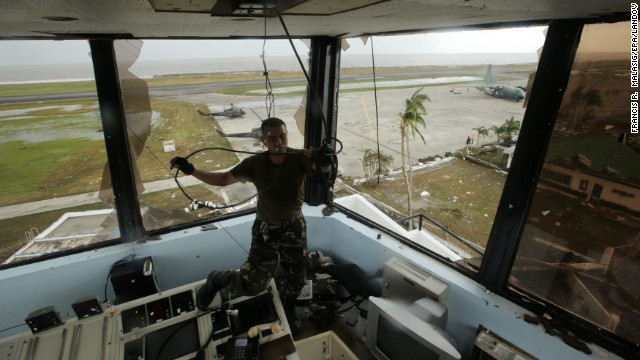 A soldier pulls a cable inside the devastated airport tower in Tacloban.
A soldier pulls a cable inside the devastated airport tower in Tacloban. 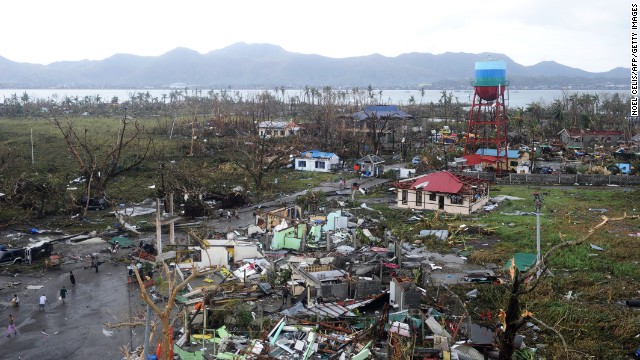 Tacloban houses are destroyed by the strong winds caused by the typhoon.
Tacloban houses are destroyed by the strong winds caused by the typhoon. 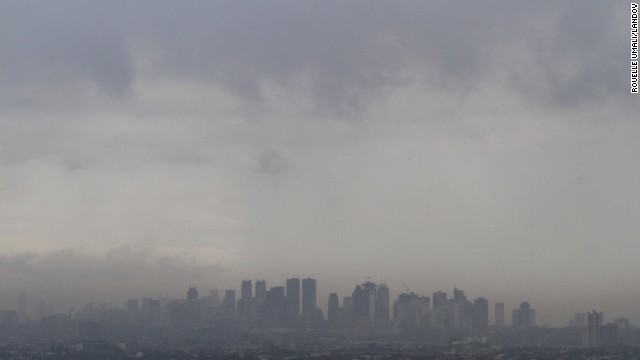 Dark clouds brought by Haiyan loom over Manila skyscrapers on November 8.
Dark clouds brought by Haiyan loom over Manila skyscrapers on November 8. 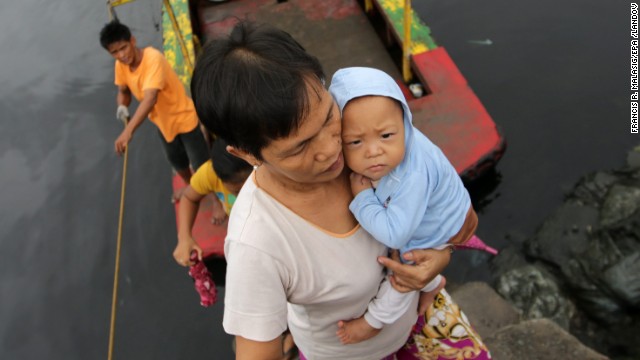 A woman carries a baby across a river November 8 at a coastal village in Las Pinas, Philippines.
A woman carries a baby across a river November 8 at a coastal village in Las Pinas, Philippines. 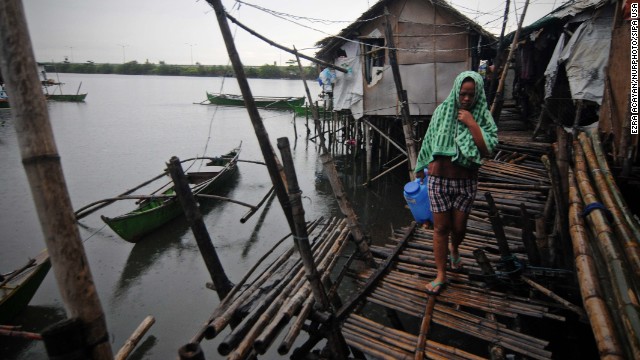 A resident walks along a fishing village in Bacoor, Philippines, on November 8.
A resident walks along a fishing village in Bacoor, Philippines, on November 8. 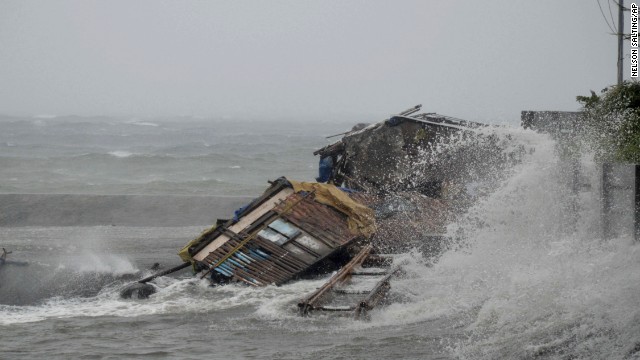 A house in Legazpi, Philippines, is engulfed by storm surge November 8.
A house in Legazpi, Philippines, is engulfed by storm surge November 8. 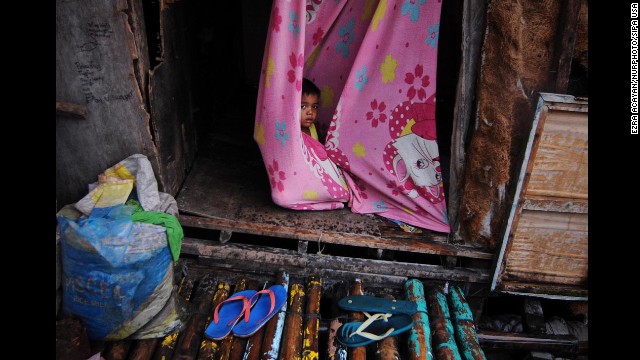 A child wraps himself in a blanket inside a makeshift house along a Bacoor fishing village.
A child wraps himself in a blanket inside a makeshift house along a Bacoor fishing village. 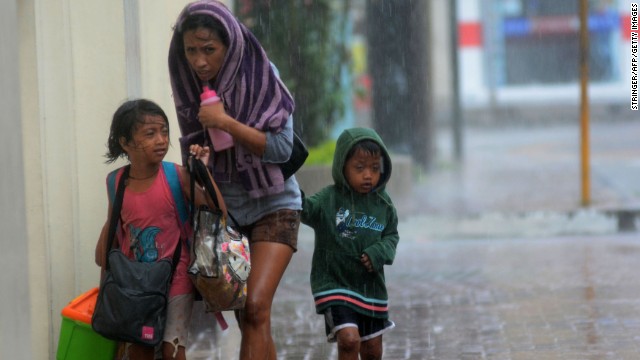 A woman and her children head for an evacuation center November 8 amid strong winds in Cebu City, Philippines.
A woman and her children head for an evacuation center November 8 amid strong winds in Cebu City, Philippines. 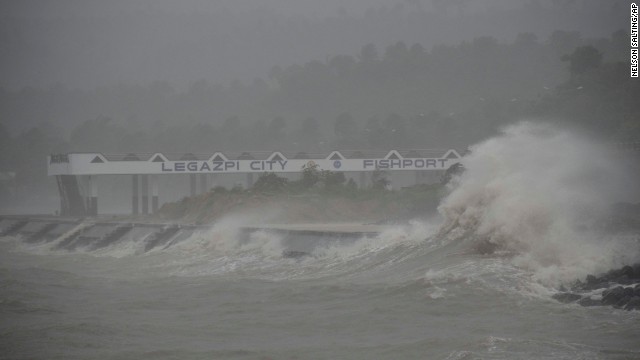 Huge waves from Haiyan hit the shoreline in Legazpi on November 8.
Huge waves from Haiyan hit the shoreline in Legazpi on November 8. 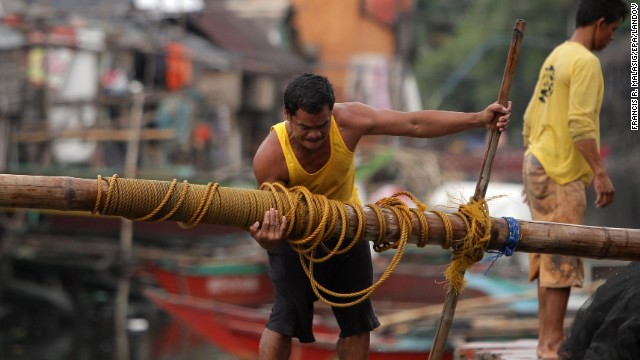 A fisherman lifts a post to reinforce his home at a coastal village in Las Pinas on November 8.
A fisherman lifts a post to reinforce his home at a coastal village in Las Pinas on November 8. 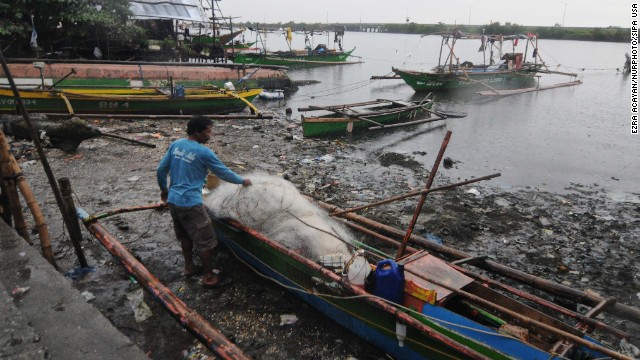 A resident unloads nets off a fishing boat in Bacoor on November 8.
A resident unloads nets off a fishing boat in Bacoor on November 8. 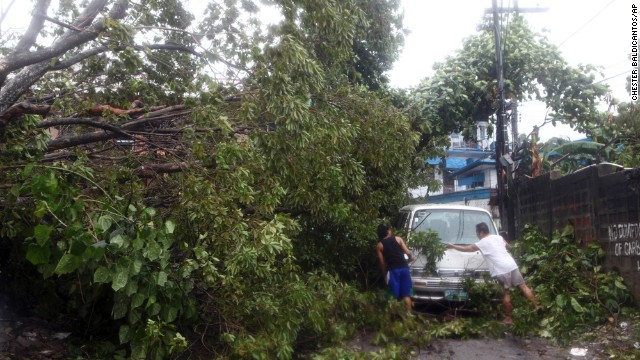 Residents clear a road November 8 after a tree was toppled by strong winds in the Philippine province of Cebu.
Residents clear a road November 8 after a tree was toppled by strong winds in the Philippine province of Cebu. 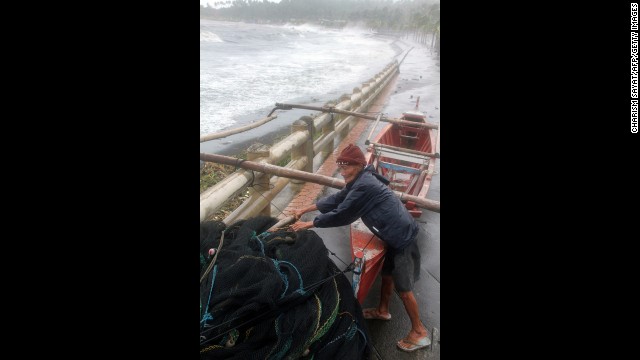 A fisherman secures his wooden boat November 8 as Haiyan's strong winds hit Legazpi.
A fisherman secures his wooden boat November 8 as Haiyan's strong winds hit Legazpi. 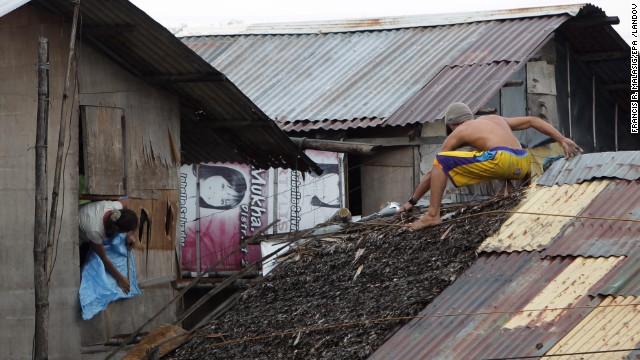 Residents reinforce their homes in Las Pinas on November 8.
Residents reinforce their homes in Las Pinas on November 8.  Legazpi residents are relocated to an evacuation center on Thursday, November 7. About 125,000 people took refuge in evacuation centers, and hundreds of flights were canceled.
Legazpi residents are relocated to an evacuation center on Thursday, November 7. About 125,000 people took refuge in evacuation centers, and hundreds of flights were canceled. 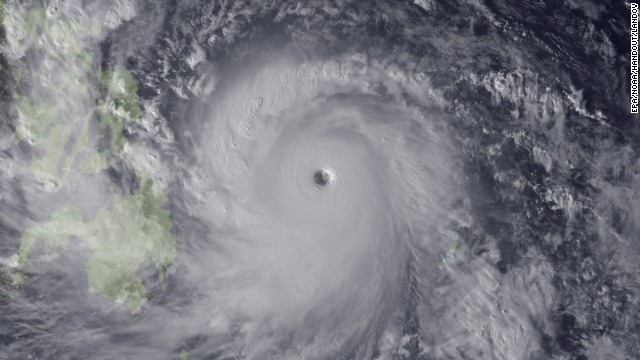 The storm approaches the Philippines in this satellite image taken November 7 by the National Oceanic and Atmospheric Administration.
The storm approaches the Philippines in this satellite image taken November 7 by the National Oceanic and Atmospheric Administration. 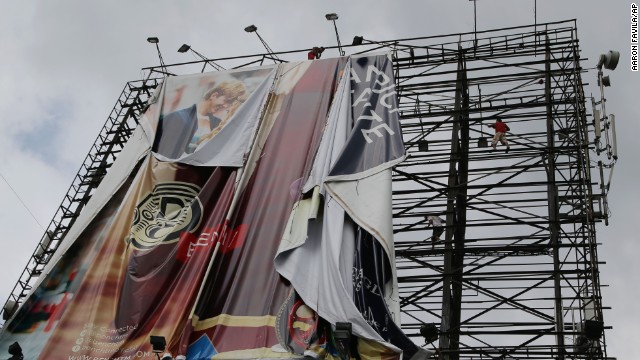 Workers bring down a billboard in Makati, Philippines, on November 7 before Haiyan makes landfall.
Workers bring down a billboard in Makati, Philippines, on November 7 before Haiyan makes landfall. 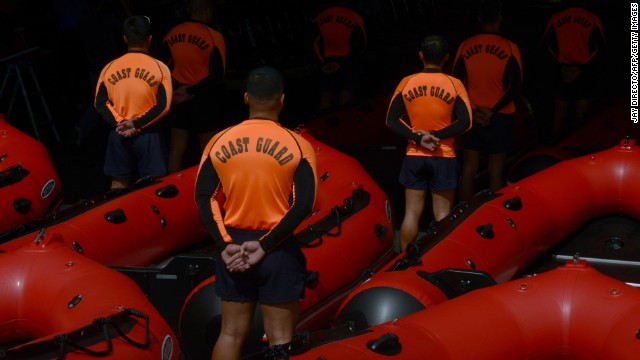 Philippine Coast Guard personnel stand in formation beside newly acquired rubber boats after a blessing ceremony in Manila on Wednesday, November 6. The boats were to be deployed to the central Philippines in preparation for Haiyan.
Philippine Coast Guard personnel stand in formation beside newly acquired rubber boats after a blessing ceremony in Manila on Wednesday, November 6. The boats were to be deployed to the central Philippines in preparation for Haiyan. 
1

2

3

4

5

6

7

8

9

10

11

12

13

14

15

16

17

18

19

20

21

22

23

24

25

26

27

28

29

30

31

32

33

34

35

36

37

38

39

40

41

42

43

44

45

46

47

48

49

50

51

52

53

54

55

56

57

58

59
- Emil Guillermo: Images of a post-typhoon Philippines are devastatingly apocalyptic
- Guillermo: While the Third World is in rubble, the First World is in the dark
- He says people around the world are worried about their loved ones in the Philippines
- Guillermo: We need to help the survivors and struggling country get back on track
Editor's note: Emil Guillermo, an award-winning Filipino-American journalist and former host of NPR's "All Things Considered," writes for the Asian American Legal Defense and Education Fund.
(CNN) -- Images of Super Typhoon Haiyan's aftermath in the Philippines appear so devastatingly apocalyptic that most Filipino-Americans remain on edge.
What news does get out only makes the situation seem more unbearable, especially when CNN viewers see typhoon survivors such as Magina Fernandez make anguished pleas in televised reports.
"Get international help to come here now, not tomorrow, now," Fernandez said. "This is really, really like bad, worse than hell. Worse than hell."

If only loved ones could hear a more reassuring message. But personal communication is slow in coming.
Relatives in the United States and around the world are turning to social media sites such as Facebook, reading Philippine-based media sites (such as Manila's major newspaper, the Inquirer) for news, all while waiting for that phone call, text or any kind of message from an unaccounted loved one.
Because of infrastructure failures, only a few individuals from the most ravaged areas such as Tacloban in the Leyte area of the central Philippines are able to communicate by cell or land line.
iReport: Are you searching for a family member in the Philippines?
While the Third World is in rubble, the First World is in the dark.
Nearly half of all the 3.4 million Filipino-Americans live in California.
Among them is Janet Alvarado, who waits for news from her home in San Francisco.
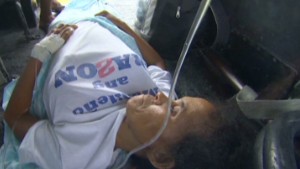 Philippines face growing health dangers
Philippines face growing health dangers 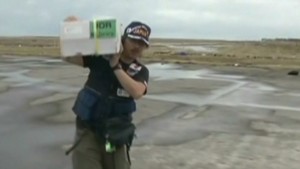 China criticized over aid amount
China criticized over aid amount Alvarado, 52, executive director of a historical project that preserves images of Filipino-American life and connects Filipino-Americans to Tacloban's main region, Leyte, has heard from just one family member.
But that's just a single strand of a large extended family in the Philippines.
Alvarado was born in the United States, but her mother, Norberta Magallanes Alvarado, 94, immigrated to the U.S. in the 1940s from Tacloban. Like many Filipinos, Norberta Alvarado came with only one of her younger brothers, meaning there are many relatives still living in Tacloban and the surrounding area.
"My mom is so worried," Janet Alvarado said. "She just gets up every day and prays."
The first positive sign came when another cousin in San Francisco was able to confirm on Facebook and through text messages that her cousin Ruseli and husband Nonoy Gula were both able to leave Tacloban safely this weekend.
"She said they just couldn't stay," Janet Alvarado said. "It smelled too much like death."
Another set of cousins, Dino Magallanes and a younger relative, were OK, too. Alvarado said they were on a motorcycle on the road from Biliran to Ormoc, another part of Leyte. Alvarado said that trip usually takes an hour, but it took five hours in the aftermath of the storm.
"They said there were just too many bodies all around," Janet Alvarado said about her cousin's experience. "The bodies were just piled up on the road."
Now the focus is on finding another cousin from Tacloban proper. But no one has heard from him.
"Armando is an engineer in his late 50s," Janet Alvarado said. "His daughter Inday is missing, too. Where they are? We just don't know. We haven't heard."
The Philippines Red Cross has reportedly set up a call service at 09175328500.
The Philippine Daily Inquirer also reported that Google has set up a person finder at 16508003977, where one enters "search (the person's name)" into Google.
iReport: Home 'wiped out,' but family is alive
But with news images looking increasingly grim, and another storm coming, hope is girded by more prayer. That's tough when even Leyte's Metropolitan Cathedral had its roof and ceiling blown away by the super typhoon, which is known as Yolanda in the Philippines.
The government is well aware of the country's vulnerability to natural disasters. Sure enough, Yolanda, the third major typhoon to hit the Philippines in three years, comes at a huge financial cost.
The Philippines has about $500 million to take care of infrastructure issues.
The personal needs of the population will have to be made up from individual Filipinos throughout the world. The country's 10 million overseas workers already provide the Philippines with $24 billion in remittances. It's much needed when about a third of the people in the Philippines live in poverty, existing on $2 a day.
The U.S. government has already committed $20 million to help the Philippines. Filipino-Americans will also be counted on to pitch in, perhaps even more than they already do.
The struggling country boasted a first-quarter gross domestic product growth of around 7.8%, outpacing China as well as India, Thailand and Vietnam. President Benigno Aquino, with an aggressive pro-business and clean government platform, seemed to be getting the country back on its feet. But now this.
iReport: 'All I could do was say a prayer'
Filipinos have always been a tough people. But the typhoon has brought despair. We need everyone who can to help the survivors and country get back on track.
In the meantime, loved ones anxiously hope that messages from relatives will come soon.
Follow us on Twitter @CNNOpinion.
Join us on Facebook/CNNOpinion.
The opinions expressed in this commentary are solely those of Emil Guillermo.







